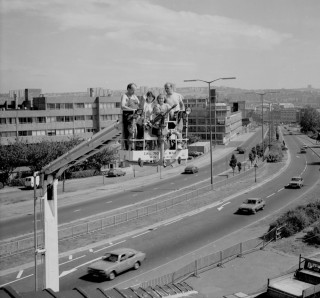Photographer Adrian Wynn's views of Broomhall in the 1980s ~ Part 2
Carnival, roof-top views and demolition
Donated by Adrian Wynn
“I rented a room in Broomhall for a couple of spells in the 1970’s though I wasn’t taking photographs at the time, and these pictures are from visits made in the early and mid 1980’s. I’ve not been back to Broomhall much in the intervening thirty-odd years, though I often drive along the dual carriageway (Hanover Way) that runs through the eastern edge of the area. I first lived there when the terraced houses that form part of Broomhall had demolition orders on them. However, it was possible to buy a house cheaply on the understanding that one day the bulldozer would turn up at your door – and you would have no redress when it knocked your house down. Landlords and graduate students with a bit of cash bought up the houses. However the demolition orders were later lifted and improvement grants became available.
There is always a difference between an area marked on a map and the same area modelled in the heads of its residents. Broomhall according to, say, Pevsner, lies to the west of Upper Hanover Street, land that in medieval times was owned by the deWickersley family of Broom Hall. To the east, towards the modern town centre were the Fitzwilliam lands that in the nineteenth century began to be developed for industrial use, principally the cutlery and metal trades. If I had to draw a mental map of Broomhall when I lived there it would largely feature the terrace housing south from the University, as far as Hanover Square, Mudfords and the ‘Hanover’ pub. To the east, via Sid’s garage on the corner of Upper Hanover Street and Broomspring Lane, was Springfield Junior School, where many of the local children went, and the Broomhall Flats. They were system-built deck-access flats that celebrated their concrete construction in a way that justified the ‘Brutalist’ tag. There were two similar schemes in other cities I think – one in Nottingham (?) – and I seem to remember the design won a prize for the architects. Which goes to show you can be a hero of the architectural profession and still design buildings that are unworkable or unliveable.
Beyond the flats but still on my mental map of Broomhall was the long gone ‘Raven’ public house on Fitzwilliam Street. Southwards was the cutlery area dominated by the factory and warehousing of Viners, the biggest cutlery firm in Sheffield. South of Hanover Square were the two tower blocks and the maisonettes also known as Broomhall Flats but which to me always belonged to London Road and Sharrow, while, to the west, the villas on the roads that stretched down to Ecclesall Road were always some variation on ‘collegiate’, a distinction later enthusiastically adopted by estate agents keen to distance their properties from some of the darker goings on in Broomhall.
When I lived there it was a place of… well , I liked it and, as always, the good people you know are what counts. It was a kind of raggedy-arsed Bohemia; but there was also poverty, drugs and prostitution. But the drugs seemed to be mostly cannabis of dubious quality (if you wanted the stronger hallucinogens you had to stroll the few hundred yards up to the Students Union) and the working girls seemed quite relaxed. This changed a few years later when the area became part of the stalking ground of the Yorkshire Ripper. From then on the tension inevitably mounted on the streets after dark and the kerb-crawling motorists took on an extra threat.
These days, so I’m told, the girls are long gone, but down on the flats the drugs are harder and there is violence between gangs. In the streets where I used to live the house prices are now such that I couldn’t afford to buy one, because there has been an equal process of what is often referred to as embourgoisement both in terms of owner occupiers and lettings to denizens of the nearby academic institutions.
By the early 1980’s economic and social forces were in play that changed the face of Sheffield. One, much recorded, was the closure of many of the city’s traditional industries. This narrative tends to focus on the steel industry but the local cutlery trade had been ailing for a while and the eighties finished off the less healthy survivors. Viners’ cutlery business had expanded greatly in the 1950’s and 1960’s and by the 70’s they were importing blanks from one of their Far East subsiduaries and stamping them ‘Sheffield’. This doubtful practice didn’t save them and they went out of business in 1982. The other process that changed the townscape was the demolition of a number of the large public housing projects from two decades earlier. The deck-access Broomhall Flats developed a mean reputation fairly early on. I don’t know the details of their demise but it was no surprise when their closure was announced in 1981-2.
The pictures from about 1985 show the demolition of Viners factory as seen from Broomhall Flats, and the last remaining section of Viners factory with the demolition of Broomhall Flats underway behind. More sympathetic housing was built on the site sometime later and, on Milton Street, the Eye-Witness Works, with Ceylon Works behind it, and Beehive Works are, today, reminders of what large scale cutlery industry once looked like. The impact of the 1980’s, meanwhile, remains to be seen largely in absences and photographs.”
You can see more of Adrian’s photos of other parts of Sheffield in his Flickr pages.










Comments about this page
I live in broomhall sheffield now in a property owned by South Yorkshire Housing Association
Add a comment about this page